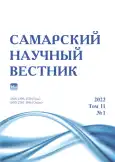The analysis of the biochemical diversity of the English oak vegetative sphere in the forest-steppe zone
- Authors: Sautkina M.Y.1
-
Affiliations:
- All-Russian Research Institute of Forest Genetics, Breeding and Biotechnology
- Issue: Vol 11, No 1 (2022)
- Pages: 114-118
- Section: Biological Sciences
- URL: https://journals.rcsi.science/2309-4370/article/view/108331
- DOI: https://doi.org/10.55355/snv2022111114
- ID: 108331
Cite item
Full Text
Abstract
The paper studies the biochemical diversity of the English oak trees growing in the protective forest strips of the forest-steppe zone in the Central Chernozem region. The features of accumulation of various groups of substances of secondary metabolism of phenolic nature in the leaves of model oak trees in seasonal dynamics are described. The role of secondary metabolites in the formation of adaptive mechanisms of resistance of individuals to adverse environmental factors is considered. It is proved that the content of substances of secondary metabolism of phenolic nature and their combination can serve as a criterion for the potential biochemical stability of trees when growing in unfavorable environmental conditions. The content of secondary metabolism substances was determined on oak leaf samples in early June and August. It was revealed that the quantitatively leading group of substances of secondary metabolism are flavonols. It was found that at the beginning of the growing season, the most significant fluctuations in the levels of accumulation of secondary metabolism substances occur in young oak leaf blades, and by the end of the growing season their content stabilizes. High rates of variation coefficients have been identified, which make it possible to ensure biochemical diversity in the population and a sufficient range of adaptability of traits. It is shown that the samples of control and experimental trees for flavonols are the most homogeneous.
Full Text
##article.viewOnOriginalSite##About the authors
Marina Yurievna Sautkina
All-Russian Research Institute of Forest Genetics, Breeding and Biotechnology
Author for correspondence.
Email: sautmar@mail.ru
candidate of agricultural sciences, researcher of Ecological Genetics Laboratory
Russian Federation, VoronezhReferences
- Калиниченко Н.П. Дубравы России. М.: ВНИИЦлесресурс, 2000. 536 с.
- Харченко Н.А., Харченко Н.Н. К вопросу о деградации порослевых дубрав Центрального Черноземья // Лесной вестник. 2007. № 4. С. 29-31.
- Каменная Степь: лесоаграрные ландшафты / под ред. Ф.Н. Милькова. Воронеж: Изд-во ВГУ, 1992. 224 с.
- Сауткина М.Ю., Кузнецова Н.Ф., Тунякин В.Д. Современное состояние полезащитных лесных полос с преобладанием дуба черешчатого (Quercus robur L.) в Каменной Степи // Лесохозяйственная информация. 2018. № 1. С. 78-89.
- Titto R.S. Phenolic constituents in the leaves of northern willows: Methods for analysis of certain phenolics // Journal of Agricultural Food Chemistry. 1985. Vol. 33. P. 213-217.
- Беликов В.В. Оценка содержания флавонол-производных в плодах Silybim maianum (L.) Gaerth // Растительные ресурсы. 1985. № 3. С. 350-358.
- Полякова Л.В., Литвиненко В.И. Регуляция синтеза некоторых групп фенольных соединений в листьях дуба черешчатого в условиях повреждения патогенной инфекции и насекомыми // Фенольные соединения: фундаментальные и прикладные аспекты: мат-лы IX междунар. симп. 20-25 апреля 2015 г., г. Москва, Российская Федерация / отв. ред. Н.В. Загоскина. М.: ИФР РАН, 2015. С. 396-403.
- Полякова Г.Г., Ветрова В.П., Пашенова Н.В., Осипов В.И. Участие проантоцианидинов и лигнина в защитной реакции пихты на инфицирование микромицетами // Физиология растений. 1995. Вып. 42. С. 622-628.
- Сауткина М.Ю. Вторичные биохимические признаки как показатели устойчивости насаждений дуба черешчатого в Каменной Степи // Труды КубГАУ. 2019. № 81. С. 178-182.
- Сауткина М.Ю. Особенности содержания веществ вторичного метаболизма в листьях дуба черешчатого Каменной Степи // Организация и регуляция физиолого-биохимических процессов: межрегион. сб. науч. работ. Воронеж: ВГУ, 2020. С. 160-164.
- Полякова Л.В. Фенольные соединения листьев материнских деревьев и сеянцев полусибсового потомства дуба черешчатого // Биологический вестник. 2007. Т. 11. С. 61-66.
- Agati G., Azzarello E., Pollastri S., Tattini M. Flavanoids an antioxidants in plants: location and functional significance // Plant Science. 2012. Vol. 196. P. 67-76.
- Полякова Л.В. Сезонная изменчивость фенольных соединений в листьях деревьев дуба черешчатого (Quercus robur) и красного (Quercus rubra), устойчивых и восприимчивых к мучнистой росе (Microsphaera alphitoides) // Лесоводство и агролесомелиорация. 2008. Вып. 113. С. 252-259.
- Полякова Л.В., Губин Е.А. Биохимическая характеристика сеянцев дуба черешчатого, используемых для размножения in vitro // Факторы экспериментальной эволюции организмов: сб. науч. тр. Т. 5. К.: Логос, 2008. С. 314-317.
- Полякова Л.В., Журова П.Т. Роль фенольных соединений в устойчивости географических культур сосны обыкновенной // Лесоведение. 2012. № 1. С. 27-33.
- Полякова Л.В., Кузнецова Н.Ф. Повышение устойчивости лесозащитных полос с участием сосны обыкновенной на основе изучения особенностей метаболизма веществ вторичного обмена // Бюллетень ГНБС. 2020. Вып. 136. С. 140-147.
Supplementary files






